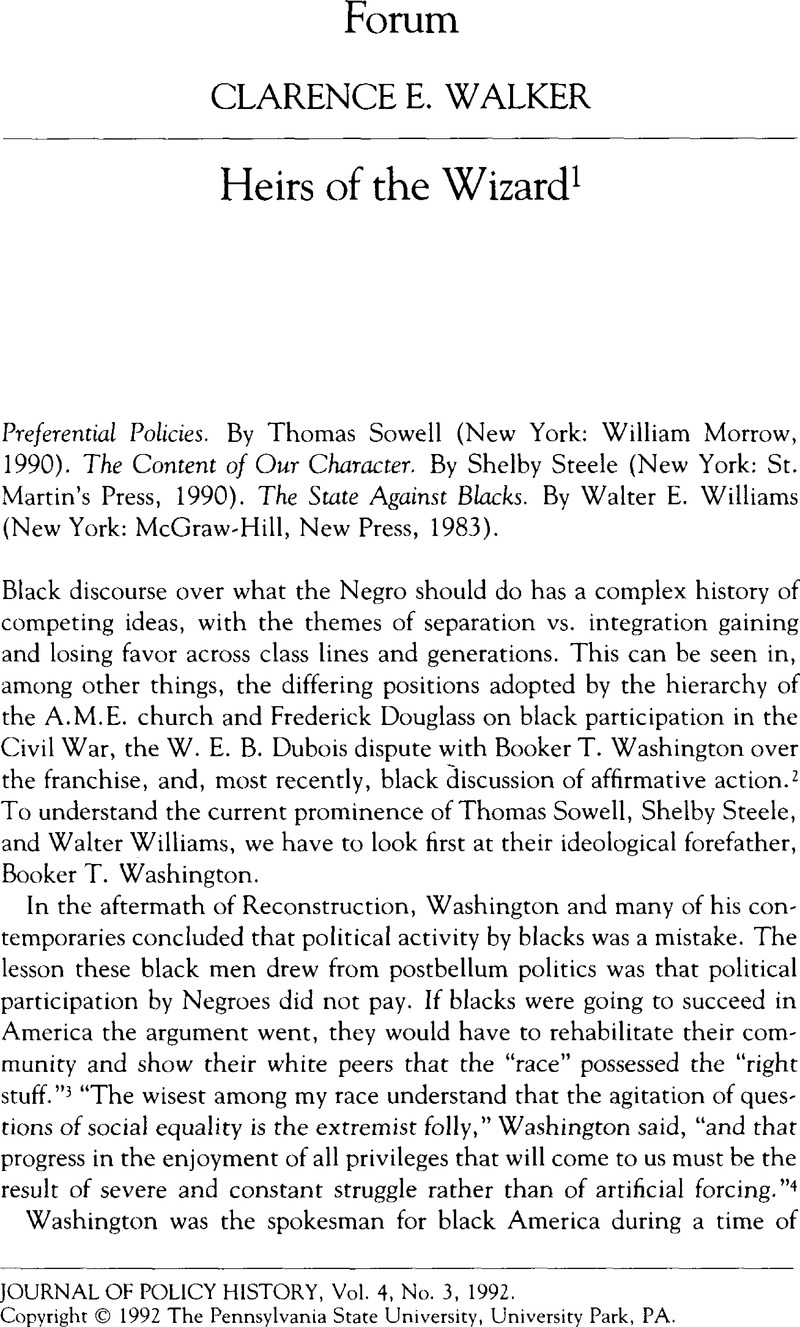No CrossRef data available.
Article contents
Heirs of the Wizard1.
Published online by Cambridge University Press: 14 October 2011
Abstract

- Type
- Forum
- Information
- Copyright
- Copyright © The Pennsylvania State University, University Park, PA. 1992
Footnotes
“The Wizard” is the nickname given to Booker T. Washington by his intimates.
References
Notes
2. See, for example, Carter, Stephen L., “I Am an Affirmative Action Baby,” New York Times, 5 August 1991Google Scholar, op-ed page; Crenshaw, Kimberle, “Race Reform, and Retrenchment: Transformation and Legitimation in Antidiscrimination Law,” Harvard Law Review 101: 7 (May 1988)CrossRefGoogle Scholar; Wilson, William Julius, The Truly Disadvantaged (Chicago, 1987), 2.Google Scholar
3. Washington, Booker T., Up From Slavery (1901; rpt. New York, 1986).Google Scholar
4. Ibid., 233.
5. These statistics are taken from Cohen, William, At Freedom's Edge (Baton Rouge, La., 1991), 211.Google Scholar
6. Washington, Up From Slavery, 40–41.
7. Ibid., 220.
8. Fredrickson, George, The Black Image in the White Mind (New York, 1971), 178.Google Scholar
9. For the specifics on the DuBois and Washington debate, see Harlan, Louis, Booker T. Washington, 2 vols. (New York, 1972Google Scholar, 1983), passim; Meier, August, Negro Thought in America, 1880–1915: Racial Ideologies in the Age of Booker T. Washington (Ann Arbor, 1963)Google Scholar, passim; and Washington, Up From Slavery, 78.
10. Walker, Clarence E., A Rock in a Weary Land: The African Methodist Episcopal Church During the Civil War and Reconstruction (Baton Rouge, La., 1982)Google Scholar, chap. 1.
11. Quoted in Grossman, James, Land of Hope (Chicago, 1989), 34.CrossRefGoogle Scholar
12. Fredrickson, Black Image, passim.
13. Williams, The State, 125.
14. Ibid., 13.
15. For the constraints on black home purchase, see Osofsky, Gilbert, Harlem: The Making of a Ghetto (New York, 1971)Google Scholar; Philpott, Thomas Lee, The Slum and the Ghetto: Immigrants, Blacks, and Reformers in Chicago, 1880–1930 (1978, Belmont, Calif.Google Scholar, 1991); Spear, Alan, Black Chicago (Chicago, 1967).Google Scholar
16. For the problems confronting black business in the nineteenth century, see Walker, Juliet E. K., “Racism, Slavery, and Free Enterprise: Black Entrepreneurship in the United States before the Civil War,” Business History Review 60 (Autumn 1986): 343–82.Google Scholar
17. Williams, The State, xvii.
18. Ibid., 20.
19. Ibid., 21.
20 Ibid., 24.
21. Ibid.
22. Ibid., xvii.
23. Ibid., xvii.
24. See chapter 8, on unions and racism. American unions were racist in the beginning of the twentieth century, and some continue to be today. But the unions defended the interest of working people, and blacks ultimately benefited from this process. For an excellent discussion of the railroad unions and blacks, see Salvatore, Nick, Eugene V. Debs, Citizen and Socialist (Urbana, Ill., 1982).Google Scholar
25. Sowell, Preferential Policies, 24.
26. Ibid., 20–21.
27. Ibid.
28. For a more complex interpretation of segregation than Sowell's, see Rabinowitz, Howard, Race Relations in the Urban South, 1865–1890 (Chicago, 1978).Google Scholar
29. Sowell, Preferential Policies, 21.
30. See Frazier, Thomas R., Afro-American History: Primary Sources (Chicago, 1988), 2d ed., 164, 175.Google Scholar
31. What does Sowell mean when he writes: “Prejudice is free but discrimination has costs”? Sowell, Preferential Policies, 22.
32. Ibid., 23.
33. Ibid.
34. Sowell's source for the German generals’ shopping habits is Sara Gordon, Hitler, Germans, and the “Jewish Question” (Princeton, 1984)Google Scholar. Gordon's explanation of this phenomenon is more complex than Sowell would have his readers think. See chapter 6.
35. Sowell, Preferential Policies, 35.
36. Osofsky, Harlem, chaps. 7–9.
37. Sowell, Preferential Policies, 181–85.
38. See “A Family Way to College,” The Sacramento Bee Forum, 16 June 1991.
39. Ibid., 111.
40. Ibid., 107–8.
41. See The California Aggie, 7 February 1991, and the letter by Ruiz, Vicki and Walker, Clarence E. in the California Aggie, 19 February 1991.Google Scholar
42. See these critiques of Steele: Reed, Adolph, Jr., “Steele Trap,” The Nation, 4 March 1991, 274–80Google Scholar; “Realism About the Black Experience,” Dissent (Fall 1990): 519–22Google ScholarPubMed; and “Shelby Steele Replies,” in the same issue, 522–23; Jerry G. Watts, “Race Problems and Moral Innocence,” Dissent (Winter 1991): 78–81.
43. Kirp, David L., “No Angels, No Demons,” San Francisco Examiner Image, 7 October 1990, 23–28.Google Scholar
44. Gramsci, Antonio, Selections from the Prison Notebooks, ed. and trans. Hoase, Quinton and Smith, Geoffrey Nowell (New York, 1977), 324–25.Google Scholar
45. Steele, The Content of Our Character, 16.
46. Ibid., 15.
47. For this point, see Degler, Carl N.,”The Negro in America—Where Myrdal Went Wrong,” New York Times Magazine, 7 December 1969, 154.Google Scholar
48. Steele, The Content of Our Character, 50, 70, 135.
49. Ibid., 15.
50. Ibid., 120.
51. See Steele, , passim. Steele's book is the American black version of Norman Podhoretz's Making it (New York, 1967).Google Scholar
52. New York Times, 13 July 1991; New York Times, 19 July 1991.
53. Steele defines himself as a classic liberal in Time, 12 August 1991, 6. This makes him a reactionary in the context of contemporary politics.


